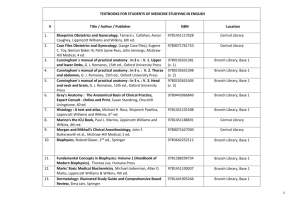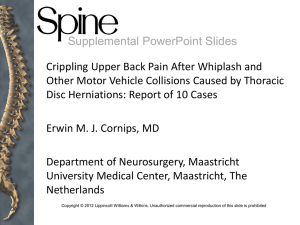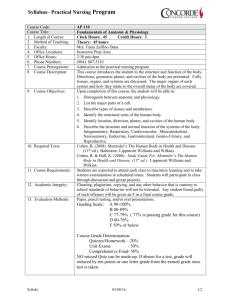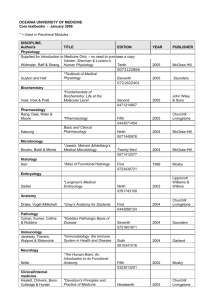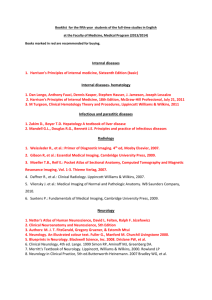Chapter 1 and 2
advertisement
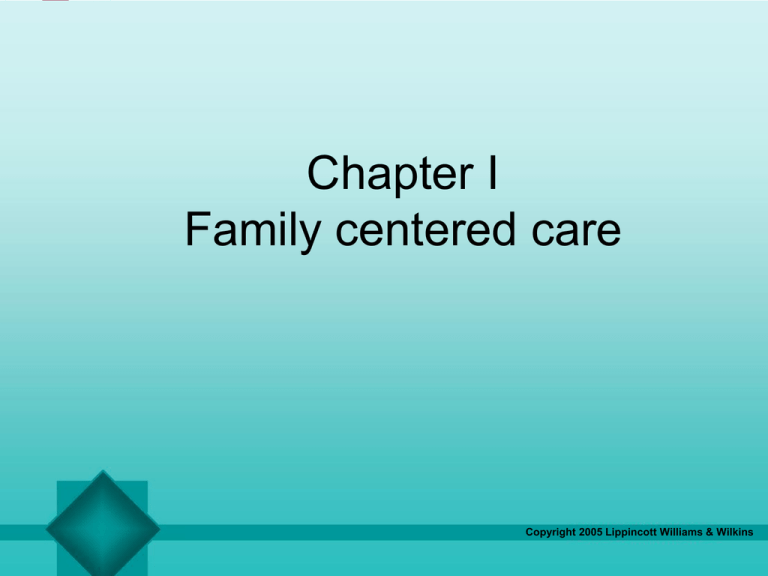
Chapter I Family centered care Copyright 2005 Lippincott Williams & Wilkins Introduction: Family centered care involves the following themes: 1- respecting each child and his family 2-respecting racial, ethnic and cultural diversity and its effect on his family perception 3-facilitationg the choice for the child and family even it is difficult times 4- Supporting the choice of the child and family to their care 5-Ensuring flexibility in examination and treatment 6-coolaborating with the child and family in all level of health care 7-helping the child to discover his own strength , confidence Barrier to family centered care: Role conflict between family and therapist can lead to role stress Role stress: a subjective experience result from lack of role clarity Copyright 2005 Lippincott Williams & Wilkins Stress Limiting Strategies (LEARN) Listen with understanding to family perception Explain your perception of the situation Acknowledge the similarities and differences Recommend the intervention Negotiate an argument on the intervention Family responses to Illness and disabilities: According to ferguson: There are 8 aspects of family responses 1- Balancing the illness with the family needs 2-Developing communication acceptance 3-attributing positive meaning to the situation 4-Maintaing clear family boundaries 5- 4-Maintaing family flexibility 6- Engaging in active coping efforts 7- maintaining social integration 8-Developing collaborative relationships with professionals Copyright 2005 Lippincott Williams & Wilkins Culture Culture affect on how people view the disability and how people treat with disability Culture is not biologically inherited but learned pattern of behavior Culture is transmitted from generation to generation Culture is shared between people Culture provides the effective mechanism for interacting with the enviroment Diversity versus Sensitivity Culture diversity refer to range of culture represented organization Culture sensitivity refers to culture competent work more effectively Culture and parental expectation There are many differences between cultures in; Definitions and interperceptions of disability Coping styles Parental interaction styles Access information and services Fitting in educational programs Copyright 2005 Lippincott Williams & Wilkins Providing family centered care intervention A model of family centered care intervention consists of : 1- Culture desire Parents are personally desire want to be engaged to be culturally aware To be flexible and learn from others 2- Culture awarness Self examination , own cultural back ground, own assumptions 3-Culture Knowledge Process of seeking and obtaining a sound educational foundation Understanding the intercultural differences lead to learning indvidual differences 4- Cultural Skill is the ability to collect cultural data regarding patient problem as well as performing culturally based physical assessment Copyright 2005 Lippincott Williams & Wilkins • • • • • • • • Some cultural Strategies for low literacy skills: Remaining non judgmental Involving family, patient Asking patient simple questions Simple instructions Repeating the information Use audio video information Supporting the individual to be independent • • • • • • • Benefits of Providing family centered care Family presence during the treatment will decrease the child anxiety Involvoing mother will help the child to recover faster Presence of parents before surgery will assist in pain management Family to family support have benifial effect on mental status of mothers Family centered care is cornerstone in pediatric emergency department Family centered care is important as a home vists for prenatal care of pregnancy women Copyright 2005 Lippincott Williams & Wilkins Benefits to health care professional: • • • • • • • A stronger alliance in promoting each child health and development Improve clinical decision making Improved follow after collaborative plan Greater understanding family strengths Improved communications among staff members More competitive in health care marketing Enhancing family child health care professional satisfaction Copyright 2005 Lippincott Williams & Wilkins Chapter II Motor Development In Normal Child Copyright 2005 Lippincott Williams & Wilkins Variability of human growth and development • Motor development and motor behaviors vary because of the influence of several intrinsic and extrinsic factors Developmental Theories Physical therapists need a deep understanding of physical aspect s of growth and development 1- Maturational theories; Maturational theories refers to as hierarchical theorie Developed by Piaget, Gesell, Bayley and Mcgraw in the early 1900 Bayley produced at 1930 Bayley scale of infant development to assess mental and motor development Maturational theories emphasize on the normal developmental sequence is common to all children CNS is the major driving force of development 2- Behavioral Theories: Behavioral Theories emphasis on conditioning behavior by the use of stimulus response approach Copyright 2005 Lippincott Williams & Wilkins • • • • Developed by Pavlvo aand bandura Manipulating the stimulus in the environment to create the response which can be positively or negatively reinforce a particular behavior Therapist may move a very distractible child from Gym room to a quite room to achieve more concentration in doing the task Manipulation of parameters of physical modalities to gain specific treatment response 3- Dynamic System theories • It based on the work of Bernstein modified by Thelen • No one system is a pre eminent director of development • Each child and infant develop certain motor milestones according to many intrinsic and extrinsic factors ( genetics, poor maternal or fetal nutrition, race, ethnic, motivation for learning, cognitive abilities) • It considers the effect of other systems other than CNS On development of the child 4- Central Pattern Generators There are specialized neural circuits produce specific movements without conscious effort known as Central Pattern Generators In absence of sensory input CPG still produce specific rhythmic movement Copyright 2005 Lippincott Williams & Wilkins Tone and movement patterns Preterm neonate less than 32 weeks Full term more than 36 Posture Scarf sign; arm passively moved across the chest in supine Full flexion no resistance to passive movement Physiological flexion Resistance to passive movement Popliteal angle passively move knee to chest 135-180 degrees 60-90 degrees Ankle dorsiflexion 60-90 degrees Less than 30 Slip through: holding from axilla NO SET shoulders Complete slip SET shoulders no slip Pull to sit Complete Head lag Head held Rooting reflex Absent Present Grasp , ASTN reflex Absent Present Copyright 2005 Lippincott Williams & Wilkins NORMAL MOTOR DEVELOPMENT SENSORY AND MOTOR DEVELOPMENT • Sensory and motor development are independent • Sensation not only provide inputs from the environment but also create awareness on our bodies, and feedback on variety of movement that occur • Early child movement and posture that occur as stereotyped reflexes provide a foundation for voluntary movement • Movements become more integrated and selective as the child has the ability to perform the isolated movements Copyright 2005 Lippincott Williams & Wilkins • The neonate (Birth till 4 weeks) • The neonate movements are determined by reflexes • In most position his body is flexed except for his neck but periodically he totally extends when he stretches or when he held upright with his feet on supporting surface • Neonatal reflexes can be succeefully observed when the neonate is comfortable and alert. Rooting reflex and suckling reflexes: Copyright 2005 Lippincott Williams & Wilkins • Moro reflex: it occurs when the baby head suddenly falls backwards, The arm immediately abduct with extended elbows , wrist and fingers . The reflex disappears at the age 6 months Galant reflex It can be elicted by pricking on the paravertebral area of the back from the bottom rib to the iliac crest the trunk flex sideway towards the stimulus disappear by 2 months • Crossed extension reflex • When the nfant in supine With stimulating sole of the foot the contralateral limb will flex then extend with adduction and internally rotation • Flexor withdrawal reflex: • Stimulate the sole of the foot ---------------the leg quickly flexed Copyright 2005 Lippincott Williams & Wilkins • Extensor thrust • The leg will extend if you put a pressure on the sole of flexed leg • Crossed extension, flexor withdrawal, extensor trust remain for 1-2 months before integration • Plantar grasp: • If you put a pressure on the ball of the foot the toes will flex remains till age of 9 months • Grasp reflex when a finger is inserted into the plam of the hand of the child followed by traction to the fingers ------------strong total flexion of child arm and fingers Copyright 2005 Lippincott Williams & Wilkins GROSS MOTOR DEVELOPMENT • A dynamic posture is essenital frame work for gross motor activities • Dynamic posture requires normal posture reflex mechanisms with normal postural tone ----stability and flexiability to allow for postural changes. • Normal motor development • Supine • 1 Month • Flexion pattern No head control • Tonic neck reflex Fisted hand • Rolling to side as a block Copyright 2005 Lippincott Williams & Wilkins • 3 Month: • • Head approach to midline Loosely closed hand Pronated forearm stronger fifth finger • 4 Month: • • Tonic neck reflex Start exploration of the hand Head in midline Alternated flexion and extension of fingers • 6 Month: • • Rolling from supine to prone Lifting of the head lifting of the leg high • 7 Month: • Symmetrical supine position Lift head as towards sitting • 10 Month • Less tolerated supine sitting up Copyright 2005 Lippincott Williams & Wilkins Prone • 1 Month: • Suspension from prone------------------Head drops • Prone position on table head rolls to side flexion abduction in arm • Flexion in hips, legs • 2 Month: • Better alignment of the head more lift head • 3 Month: • Lift head with holding on forearm with extend hips and knees Copyright 2005 Lippincott Williams & Wilkins • • • • • • • • • • • • • • • 4 Month If suspended good alignment of head and trunk Holding head, leg in midline position Tendency to falls to side 5 Month Swiming on the floor holding head up with flexed arm With extended legs 6 Month Rolling from prone to supine 7 Month Well lifting of head Lifting arm 8 Month Moving from prone to sitting and vice versa. Getting on hands and knees Copyright 2005 Lippincott Williams & Wilkins • 9 Month • Pivoting on the trunk backward • 12 month • Easy Crawling • 15 Month • Bipedal walking Moving Copyright 2005 Lippincott Williams & Wilkins SITTING • • • • • • • • 1 Month From supine to sitting head sags and falls back Rounded back 2 Month From supine to sitting head erect for short period Jerky movement 3 Month supine to sit head sets forward but bobs in sitting • 4 Month • Supine to sit head slightly sags • In sitting head erects forward, Lumbar curve start to appear no cervical curve Copyright 2005 Lippincott Williams & Wilkins • • • • • • • • • • • 6 Month From supine to sitting lifting of the head Sitting on the chair with erected trunk 7 Month Sitting alone Leaning forward Active balance 10 Month Sitting for long period Getting to sitting from prone 11 Month ----------------piovting in sitting Copyright 2005 Lippincott Williams & Wilkins • • • • • • • • • • • • • STANDING AND WALKING 3 month Supporting from axilla, partial weight bearing lift feet 4 Month Supporting from axilla, extend leg tendency to flex legs 7 Month Supporting from axilla More weight bearing bouncing 9 month Full weight bearing Walking sideway, erect position holding rail( holding on ) 10 Month----------------Lowering on knee during standing 11Month--------------Walking holding rails 12 Month--------------- Walking holding one rail 15 Month------------------walking alone, ascending up stairs holding on rail • 21Month • Squatting, ascending up, descending down stairs Copyright 2005 Lippincott Williams & Wilkins Prerequisites for normal movement • • • • 1- Nervous system well formed, intact normally functioned 2- Good environment(adequate appropriate nutrition) 3-Challenges and rewards 4-Ability to learn, act • Growth: quantitive changes in behaviour like length, weight and head circumference. Development: qualitative changes in behaviour skill like head control, trunk control, ability to sit, ability to stand. Maturation: Righting referred to elaboration of nervous system structures Growth Motor: ability of the child to assume and maintain certain position such as sitting, standing 1- Head Control Prerequisites 1- Intact vestibular system 2- Intact eye and optical pathway 3- Intact muscular of the neck(muscle , jiont, ligaments) 4- Intact proprioceptors of neck • • • • • • • • Copyright 2005 Lippincott Williams & Wilkins • Age and steps: • • • • • • • 1- From birth to one month In prone position Tilting head sideway to clear nasal airways 2- From 1-2 month raise head in prone to 45 degree 3- From 2-3 month prone on elbow raise head 90 degree with support on forearm 4- from 3- 4 month prone with raise head and support on arms, hands 5- Around 3,4 month----------stiffness of trunk , head ready for sitting 6- From 3 to 6 month --------- come to supine , with pull to sit ,he can control his head 7- From 6 to 7 month--------- come to side lying Copyright 2005 Lippincott Williams & Wilkins • 2- Rolling: • Prerequisites: • • • 1- head control even partial 2- proper neck righting reaction 3- Ability to support on forearm and hand • • Sequence: It start as reflex in first seven month till be voulantary Steps: From supine to sidelying , from prone to side lying , from prone to supine Age: 1- From supine to sidelying From 1 to 4 month 2- Come to prone 4 to 5 month 3- come to supine 5 to 7 month • • • • Copyright 2005 Lippincott Williams & Wilkins • 3- Sitting: • Prerequisites: • • • a- Head control b- Trunk rotation and pivoting c- Ability to extend trunk against gravity d- Ability to support weight on arms. • 4- • • Creeping: Like Quadruped position Head, trunk control, Trunk rotation Ability to make reciprocal movement Ability to support on hands and knee Age from 6- 8 Month • 5- Standing: • • • • • Head, trunk control, Trunk rotation Ability to make reciprocal movement Postural reaction, Protective Reaction Steps: 10-10.5--------------pull to stand from supine 11- 12 month -----------------Standing holding on 13---15 month ---------------Standing alone without support • 6- Walking: • • Prerequisites Prerequisites Head, trunk control, Trunk rotation Ability to make reciprocal movement Postural reaction, Ability to bear weight on lower limb Copyright 2005 Lippincott Williams & Wilkins SPEECH • • • • • • • • • • • • • 4-6 Weeks Sounds which reflect to emotional and physiological state 12 Weeks Sounds used for communication with others 8 Months Simple short sentences 9 months One meaningful word like ma ma 1 Year Beginning of understand, Imitate adult Using expression give it to mama 2 Year -------------More clear explanation 3 Year-------------Putting Words together to form a sentence Copyright 2005 Lippincott Williams & Wilkins • • • • • • • Age : 12 month------------- Walking with support 15-18 month------------Walking alone (guard walking: abduction in both upper, lower limbs with flexion in elbows 2 years----------- walk up and down stairs 2.5 years---------- jump, stand on one foot 3 years---------- jump or run 4 years------------------ walk in one line • • • • • • Development of weight 1- Average weight for full term baby------------ 3.5 Kg 2 First 6 month of life-------------- increase weight by 20 gm/day 3- Rest of first year----------------increase weight by 10 gm/day 4- During 2 years weight decrease to 2.5 Kg 5- In next 2 years ----------increase average weight by 2 Kg/year • • • • • Development of Length At birth ----------- Average length 50 cm At first year--------Average length increase 25- 30 cm At two years----------Average length increase 12 cm In next few years------Average length increase 6-8 cm • - Copyright 2005 Lippincott Williams & Wilkins FINE MOTOR DEVELOPMENT • Shoulder stability, good posture and normal arm movements are all useful for fine motor development • Vision is not only essential for manipulating skills but also grasps and release and good sensorimotor control of fingers and hands are essential. • • Fine motor development occurs in 3 sequences: 1-Early reflexes and basic voluntary movements • 2- Development progress from the proximal parts of the arm to distal • 3- pronation of forearm before grasp, grasp before release Copyright 2005 Lippincott Williams & Wilkins Early Reflexes and reaction • • Grasp Reaction: Neonate does not show true grasp reflex but Tonic reaction of the fingers. Insertion of finger in hand then traction -------------------strongly flex in whole arm • 4 Month: • Grasp reaction ----------- gentle stimulus touch radial or ulnar aspect of hand • 6-7 Month • When stimulus touch ulnar side of hand-------pronation • When stimulus touch radial side of hand-----supination • Integration of hand with vision---------10- 11 Month • Avoidance reaction; • Up to the age of 6 months avoidance reaction occur when infant grasps object , fingertips touch object may involuntary open---------------- Droping the object Copyright 2005 Lippincott Williams & Wilkins Age Skill 1 Month Hand clenches on contact, Drops object immediately 2 Month Grasp in pronation 2- 3 Month Retains rattle briefly 3 Month Holds rattle actively 4 Month Reaches with two hands 5-6 Months Release object by dropping or throwing 6 Months Grasp cube with palmar grasp 7 Months Grasp object in half supination 9 Month Release object in larger container 10-11 Month Grasp integrated with vision 12Month Fine pencil grasp, release in small container Copyright 2005 Lippincott Williams & Wilkins 12-18 Months Grasps pencil in fisted hand 18 Months Builds tower of 3 cubes, pencil held in pronated hand 2.5 Years Builds tower of 6- 8 cubes, train from lines 3 years Imitate bridge from 3 cubes, cut with scissor 4.5-6 Years Hold pencil in tripod Reaching : 4 Month : infant tries to reach out with flexed arms 5 Month: further reaching out 6 Month: Start to develop eye hand coordination Eye hand coordination: 5 Month visually initated reaching-------------indication to direction of reaching 6 Month visually directed reaching he can correct direction of reaching 12 Month visually locate the object able to rech woith supination Copyright 2005 Lippincott Williams & Wilkins • • • • • • • • • • Voluntary Grasp: 3 Month : Infant will grasp a small cube only when it touch him 4 Month: Infant will be able to locate and grasp the cube Ulnar Palmar Grasp: Grasp with all flexed fingers and adducted thumb+ pressing the object against ulnar side of the palm Radial Palmar Grasp:-------------------6-7 Month: Radial digital grasp------------ 8 Month Scissors grip----------------------8 Month Inferior pincer grasp--------------9 Month Fine pincer grip-----------------------12 month Copyright 2005 Lippincott Williams & Wilkins
